African clawed frog (Xenopus laevis) is a kind of South African water frog of Xenopus family. This is one of few frogs that are kept in tanks. It has become one of the favorite ones among aquarists due to clawed frogs plainness in terms of keeping, breeding and its unusualness.
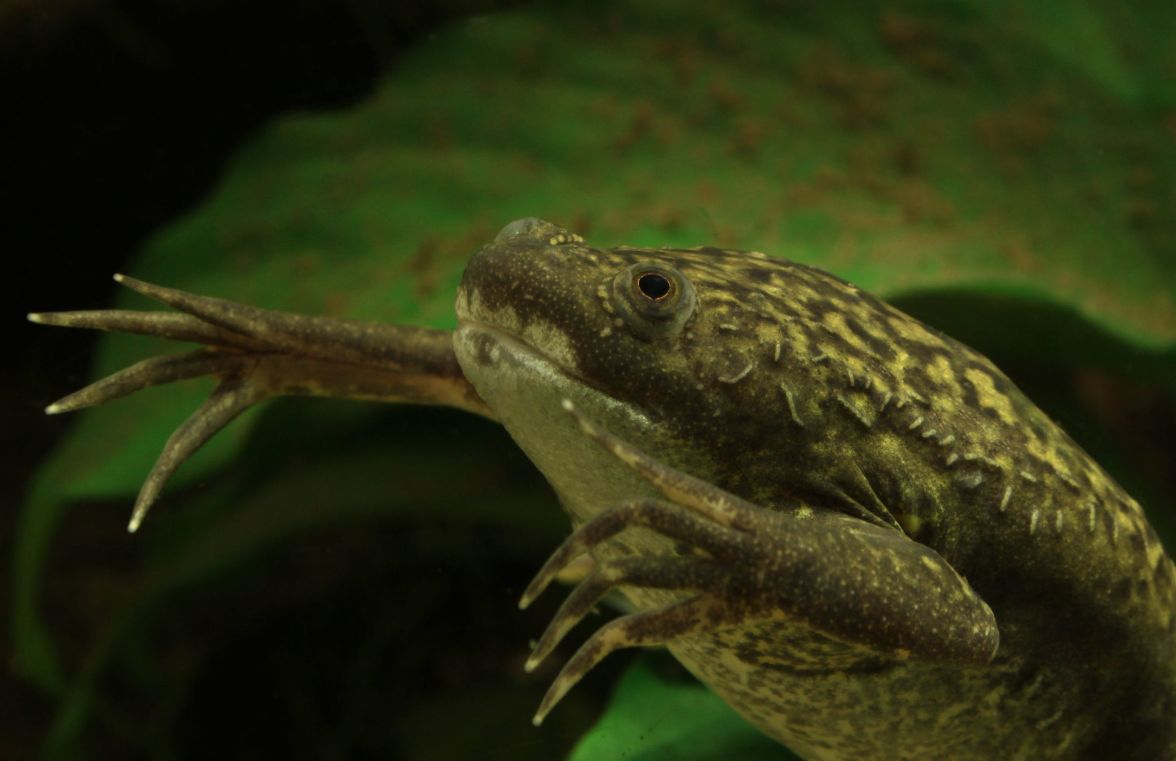
Contents
Habitat in the wild
African clawed frog inhabits Africa (Kenya, Uganda, Kongo, Zaire, Cameroon) and it has several subspecies with different habitats and size. This frog was brought to France, Portugal, Great Britain, Ireland, Italy (Sicily island), South and North America (the USA, Mexico, Chile), Indonesia.
Nominative species of Xenopus family are 13 cm long (in tanks they are smaller as a rule) and they inhabit various freshwaters – lakes, rivers, bogs and ponds.
The african clawed frog also likes lentic waters. It lives and feeds only under water and helps itself with its fore feet to put the food into the mouth. This frog preys on various spineless species, larvae and uses toxic secretion of glands on its skin as the way to protect itself.
The african clawed frog got its name due to three pairs of horny nails or claws on its hindlimbs that it uses to eat its food and for protection. The african clawed frog tears its prey with the claws to make it smaller and easier to swallow; also the claws serve for self protection. If you catch this frog, it folds its strong hindlimbs to its head and then unbends them abruptly trying to cut its enemy with the claws.
Another interesting fact is that african clawed frog is used in various biological studies as a test animal and it was the first vertebrate animal to be cloned.
| Scientific Name | Xenopus laevis |
| Family | Pipidae |
| Common Names | African clawed frog; clawed frog; xenopus; platanna |
| Range and habitat | Africa |
| Size | 10—13 cm (4-5 inches) |
| Lifespan | 15—25 years |
| Ease of keeping | Easy |
| Minimum tank size | 40 liters (8.8 gallons) |
| Temperament | Peaceful |
| Diet | Omnivorous |
| Temperature | 21–27 °C (70–81 °F) |
| pH | 6.0-7.8 |
| Water hardness | 5-15 dGH |

Description
African clawed frog general length is up to 10—13 cm (4-5 inches). The african clawed frog lifespan is about 15—25 years. The body is strong and thickset. It has small flattened head, short rounded snout with upward nostrils and small eyes with round pupils.
In a cavity behind the nostrils there are two bags by means of which it can smell the air. Its upper lid has atrophied and transformed into a small skin fold and both this issue as well as the tongue reduction happened due to its water way of life.
The fore feet are short and the hindlimbs are long with long fingers that are connected with each other by means of wide webs, three fingers have sharp claws. There is a lateral line on the body side that land frogs doesn’t have at all, while water ones still have it.
The coloring of the wild form of clawed frog is dark – it’s back color varies from olive green to deep-brown; the coloring is either sole-colored or it has large spots of ungeometrical shape. Its abdomen is white or yellowish, sometimes with brown spots, but more often it is sole-colored.
African clawed frogs with this kind of coloring are very seldom encountered in tanks, albino form is more widespread in this respect. Albino african clawed frogs have red eyes and pinkish or white body.
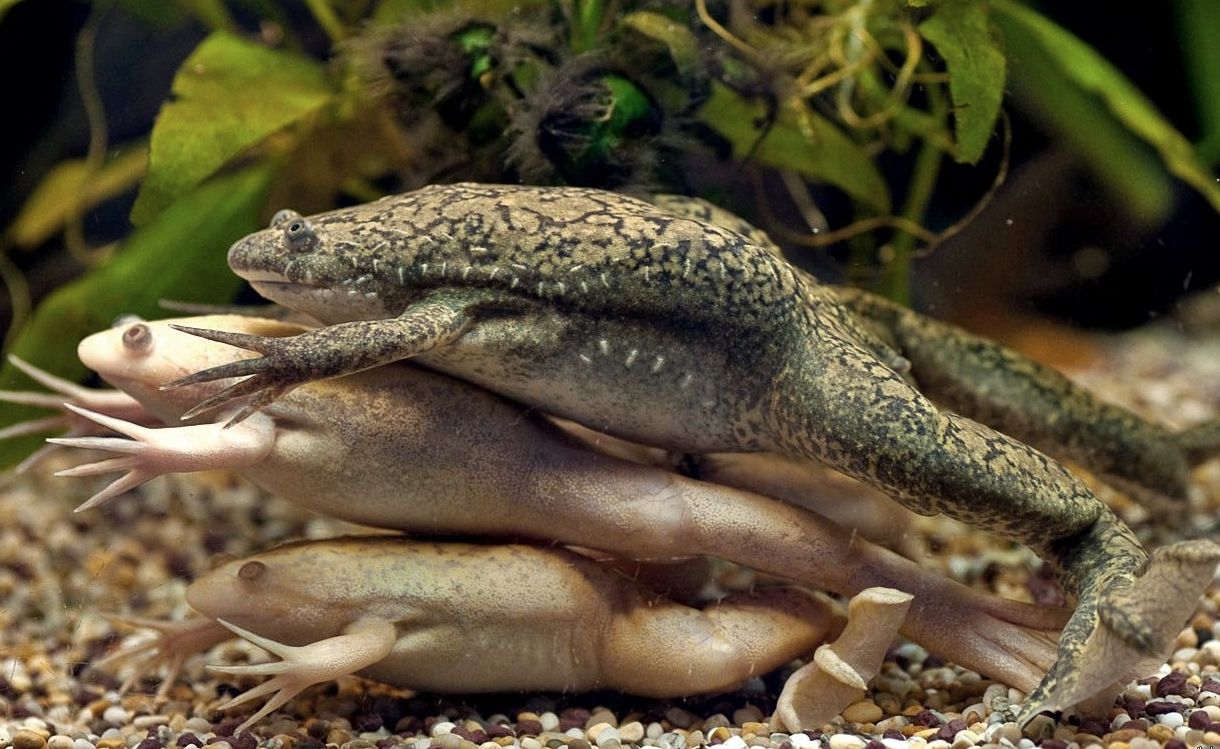
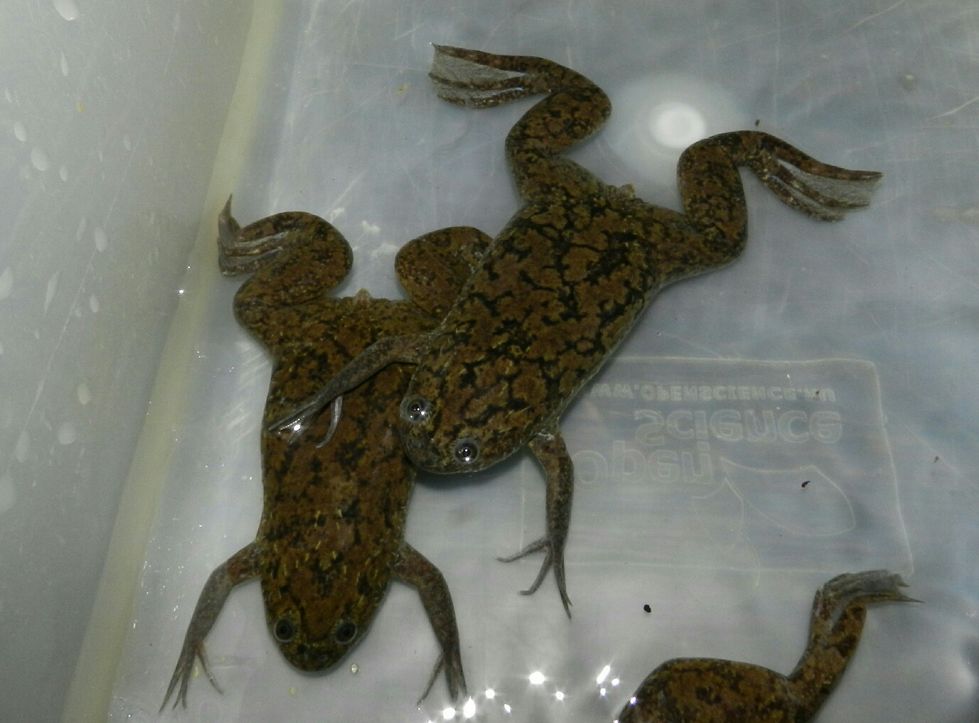
Difficulties in keeping
The african clawed frog is not demanding at all, therefore it can be successfully kept even by beginners. However, it has few minor demerits. The frog is large and while making its way over the tank bottom it breaks and outroots tank plants. Another thing is, that it is a predator, so it may prey on small fishes.
Care and keeping in a tank
Tank size
It’s better to keep african clawed frogs and tank fishes separately; tank volume for the frogs should be not less than 40 liters (8.8 gallons) for a couple. You can also keep one in such a tank, but they look more appealing and behave better if they have a company of their kind.
You can also keep them in a group of one male and several females, but bear in mind not to put male species together in one tank because of possible rivalry between them.
Tank decor
Between the tank lid and water surface there should be a small space to let the frogs breathe with atmospheric air. The lid is also necessary because if the african clawed frog has a chance, it’ll jump out of the tank. By they way, they can’t move well on dry land.
As for the tank bottom substrate, you can use not large smooth gravels, since the frogs have very tender skin and sharp stone edges may damage it. Sandy bottom isn’t a good idea, because they dig a lot and water in the tank will be muddy due to the sand on its bottom.
Since clawed frogs like digging the bottom, it’s better to protect the flower pots surface and decorate it with large stones or to close it with a net, to make sure that the plants won’t be dug out.
Water parameters
Put some snags and large stones to create shelters for your frogs; as for tank plants, you can use both natural and artificial ones. These frogs like gnawing soft tank plants, that’s why it’s better to put large coarse leaved plants in flower pots.
Tank water temperature has to be maintained at about 21–27 °C (70–81 °F), as a rule you will get it by using central heating system in the room. But if the temperature gets lower than 20 °C, you have to put a heater inside the tank.
As for hydrochemical water properties such as pH and hardness the african clawed frogs are not demanding: average pH and hardness values will suit them, however nitrites and ammonia are bad for them, so there should be minimal level of these in a tank.
As for the tank equipment, water filter is a must. Because as the result of their activities the frogs produce quite a lot of waste and the filter will let you keep the tank water clean. If the tank is small, internal filter is enough for this purpose.
Since the african clawed frogs produce quite a lot of waste, you have to clean the tank regularly – weekly water renew is a must (20% of the total tank volume) as well as cleaning the bottom substrate, tank walls, filter.
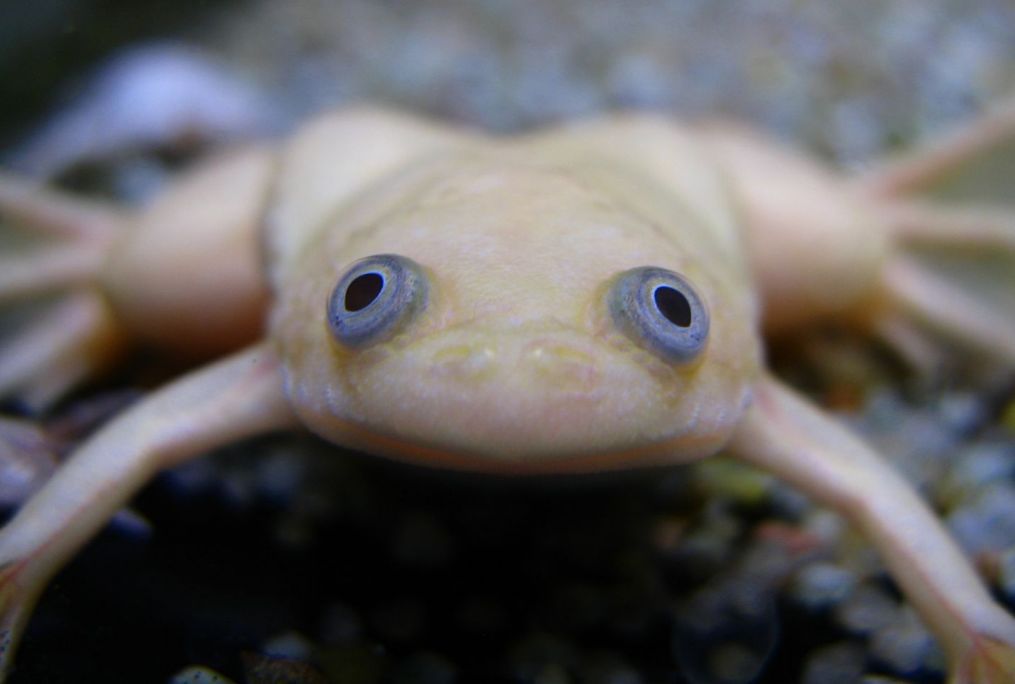
Feeding
In a tank young african clawed frogs are fed with bloodworm, tubifex live or frozen. The adult species eat bloodworm as well, but large sized and worms, new born mice. You can train to eat sliced seafood – prawns, calamari.
As for those who like watching how predators feed, they can put some foraging fish into a tank – for example, guppy and watch how the frogs prey on them. Clawed frogs are prone to gluttony and it’s important not to overfeed them. It’s better to feed adult once in two days, as for the young ones – you should feed them every day.
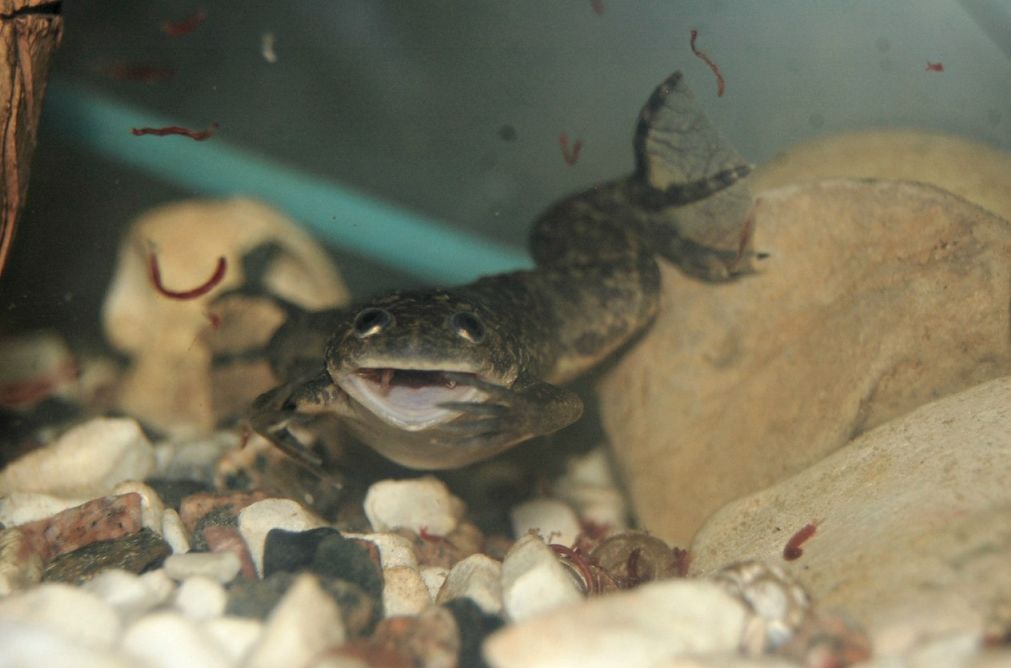
Tank mates
Clawed frogs are predators, in the wild they feed on small fishes and spineless species and everything they can swallow. In a tank the frog demonstrates the same behavior, that’s why keeping them with small sized fishes like (guppies, neon tetra) is a bad idea, since the frogs will eagerly prey on the fish.
As for large cichlids (Texas cichlid, red terror cichlid) as well as climbing perch species (giant gourami) they can prey on the frogs themselves and if they don’t kill them, they will definitely hurt them or even bite off their fingers. Anyway, such tank mates isn’t a good idea and you shouldn’t keep them together in one tank.
Gender differences: male vs female
Unlike other amphibians it is easy to tell between african clawed frog male and female. The latter is noticeably larger than the male (this is due to a very interesting way of the breeding) and it has three skin folds covering its cloaca.
Breeding
African clawed frogs becomes reproductive at the age of 2 years old. Mating and breeding lasts for the whole summer. During this time the male develops kind of black stripes along its fingers and along its limbs.
In the wild breed from August to December, but as a rule on sale you can see the african clawed frogs that are bred in tanks regardless of their mating season. That’s why you can put them for spawning at any season.
To stimulate the spawning process you should create hibernation. You should prepare them for this gradually: first, turn off the heater, several days later the frogs are put in a small tank and taken to a place where the temperature is 5 – 8 °C.
There they spend two weeks and then you have to put them into an ordinary tank. Few days later turn on the heater and start feeding and make the tank water temperature about 22 – 25 °C.
After this put the african clawed frogs together.
Spawning usually starts at night – the male tightly holds the female with its fore feed and joins their cloaks, they can stay in this pose for several hours, till morning as a rule. After spawning the frogs start shedding, at that the skin first sheds on their limbs and then the process moves toward the mouth and finally swallows the shed skin.
Approximately in an hour or hour and a half the african clawed frog female starts to lay eggs on tank plants, sticking them to their leaves. The female can lay one or 3-4 eggs at once. Clawed frogs are very fertile – the number of the eggs may be about 15,000.
Larva grow quickly and leave eggs in two days, by this time they don’t have external gills and when nutrients in their yolk bag come to an end, the larva starts using lung respiration and this is when you should start to feed them.
As for the feeding type, the larva are filter-feeding organisms and food for them has to be small sized, dust like.
Frozen food is used to feed the african clawed frog larva – cyclops and dusty like food for juveniles. The food should be present in a tank with larva all the time; renew up to 40% of tank water with fresh one having the same parameters every day. This way you’ll prevent accumulation of ammonia, nitrites and nitrates in the tank water.
It is good if the tank for larvae has no bottom substrate and decorations, but it has a filter, compressor and heater (if necessary). In 2,5 – 3 months larva transform into adult, the metamorphosis itself lasts about 20 days.